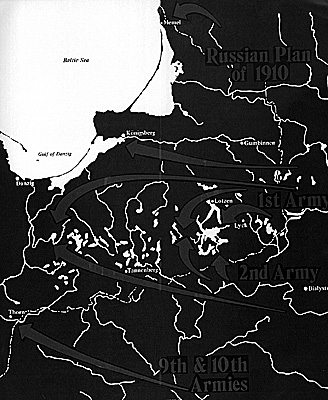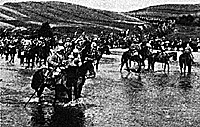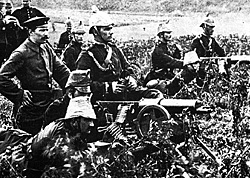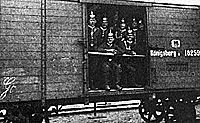This article will discuss why the "Russian Steamroller" failed to roll. By taking a look at the original Russian plan and why it took that shape, we intend to prove that a Russian disaster was the only possible consequence of the ill-planned, ill-lead, and ill-equipped invasion.
Just as the route of invasion in the West was
dictated by topographic considerations (thru the
Flanders Plain rather than the Vosges Mountains), so
too was the invasion of East Prussia. Any invasion of
Germany proper, without clearing East Prussia first,
would be inviting an attack upon the lines of
communication. Once East Prussia could be cleared,
the Russian forces could begin to acquire secure
flanks (the Baltic and the Carpathians) for an advance
on Berlin, only 180 miles from the Polish border.
Chief Obstacle
The chief obstacle to any Russian advance would
be the chain of the Masurian Lakes and the forts
between them. Any invasion must not only allot
masking forces against the lakes, but also consist of
separate forces around each end of the lake to avoid
either a flank attack or a total loss of the lines of
communication. The army marching north of the lakes
would have sufficient railroad communication, but the
southern army would lack this means of quick
support.
Mobilization
The forces engaged would be as important as the
terrain. The Schlieffen Plan was based on superior
speed of mobilization and concentration. Ideally, each
corps' district would mobilize not only the regular Army
Corps (usually kept at 75% of strength), but also a
Reserve Corps, four Ersatz Battalions, eight Landwehr
Regiments, auxiliary troops for the Ersatz and
Landwehr battalions, plus Landsturm troops to take
over guard and administrative duties.
Thus, the 800,000 man peacetime army could be
increased to over 5,000,000 men; all trained, all coming
from the same area for quick mobilization, and all well
equipped. The Russian mobilization was much different
and quite slower. The regular army was kept at 50
percent of wartime strength, the rest of which was
filled by ill-trained reservists upon mobilization. Russia
planned to supplement her 79 Regular Divisions by 35
Reserve Divisions; but, since the average reservist had
to travel 700 miles to reach his unit (the country was
not divided into districts as was Germany), it would be
at least a month before they could begin to take the
field. Surplus reservists were formed into depot
battalions, rather than formed into Ersatz divisions, a
move caused by the scarcity of artillery.
The Opolchenie, 6,500,000 older and untrained
men, was wisely not called out. In the first month, only
800,000 men could be added to the regular army of
1,400,000, of whom not all could even reach the front
from the Urals, Siberia, and the Caucasus. Russia, to
be sure, could mobilize 4,500,000 men, but it would take
at least six weeks longer than either of their opponents.
She was, therefore, forced to strike early with the best
of her forces, and to accept casualties from her only
means of rapid expansion.
Russian units, and individual soldiers, were inferior
to their German opposition. The problem of securing
officers and non-coms for the Russian army was never
solved. (Only half of the troops could read or write.)
Their units were composed of two-thirds Russians and
one-third subject nationalities during peacetime. Upon
mobilization these units were filled with local reservists,
thus often increasing the proportion of subject races,
since many of the units were stationed in areas of
probable trouble.
The Germans had the best officers and N.C.O.'s
on the continent, and the few Poles in the army
were so well distributed as to virtually disappear.
For these reasons, the German soldier displayed more
initiative and independence than his more clumsy
Russian enemy.
Russian Command Ineffectiveness
Not only did the Russians have inferior
transport and training, but, their commanders were
far inferior to their German counterparts (with one
exception: von Prittwitz). Jilinsky, Commander-in-
Chief, Northwest Front, was a capable desk soldier.
However, he was unpopular with his subordinates, who
often ignored his orders, and did not possess the
confidence of the army as a whole. Rennenkampf was
the better of the two generals in command of the
invading armies. Still, he failed to use his cavalry
reconnaissance properly, but, at least in the eyes of the
Russians, his personal courage made up for this.
Samsonov had not even told his staff about his
appointment to command the Second Army in case of
war, so they could not have prepared plans for the
initial advance. Over-confidence, lack of food and
ammunition, and - disregard of reconnaissance made
his defeat inevitable.
German Commanders
Von Prittwitz was the weakest of the German
commanders. He did not have control over his corps
commanders, and also was subject to panic when the
decisions were his alone. Ludendorf was an ideal pick
to head a German army. Believing in himself and the
invincibility of the German army, he was not afraid to
make the necessary decisions, especially when the
responsibility for the decision was in Hindenburg's
hands.
Hindenburg, called from a retirement (caused
indirectly from defeating the Kaiser in the 1908
maneuvers) to command the Eighth Army, was also an
ideal choice. Believed to be the bulwark behind
Ludendorf's decisions, he had a strength of character
all his own, which was to outlast even Ludendorf's brilliance.
The German war plan (Schlieffen Plan) called for
one army in East Prussia, along with Landwehr and
Landsturm troops in Silesia. Earlier German plans, up
until the 1890's, had called for an initial attack in the
East, but a series of fortresses, behind which a Russian
army could be immune from disastrous defeat, had
caused a shift in emphasis from East to West. The light
forces in the East were to slow up the Russian
advance, so that, in eight weeks or so, the victorious
main army could be shifted from France to defeat the
advancing Russians before they could reach Berlin.
Russian 1910 Plan
Under the 1910 Plan, the Russians had two
variants, neither of which indicates any desire to
concentrate a superiority of force against either the
Germans or the Austrians, while holding the other with
a minimum force. Under "Variant-A" the Russians
dispose 30 divisions against a possible 16-25 German;
43 against a possible 43-47 Austrian; with 13 divisions
in reserve and 28 in transit.
Under "Variant-G" the Russians dispose 41
divisions against a possible 67 German; 32 divisions
against a possible 43-47 Austrian; with 13 in reserve
and 28 in transit. On 8 August, 1914, the Russians had
21 divisions against 11 1/2 German and 35 divisions
against 3 Austrian armies, which were just moving up
into position, with reserves at Brest-Litovsk. (This plan,
seemingly, having been a modified version of "Variant-
A" of the Plan of 1910. ) Russian staff talks had called
for a concentration of 800,000 men against Germany on
the 15th day of mobilization, but a desire to reach this
figure and to aid the hard pressed French caused them
to disregard their plan and advance before they were
ready.
Unlike the factors which are common to most
battlefield decisions, there existed in 1914 a new factor
which led to the eventual disaster of the Russian
invasion: the radio. The armies of 1914 were all
equipped with this new device, and used it to send
orders in code. The Russian method of transmitting a
message in code and then, due to a lack of operators,
transmitting the same messages in clear, quickly led to
the breaking of the code.
During the course of the month of August, for
example, two important messages were, thus, decoded
by the Germans, giving the positions and intent of the
Russians. As the German Official History states,
"Eighth Army was informed of their opponents'
intentions in a way which seldom happens in war."
General Mobilization
On 6 August, the Russians decided on a dual
offensive against Germany and Austria. By the 10th,
orders for the advance of the two Russian armies was
ordered. The First Army; consisting of three corps, one
rifle brigade, five cavalry divisions, and one cavalry
brigade (fighting strength: 74,600 rifles, 19,250 satires,
208 machine guns, and 384 guns); was to advance
north of the Masurian Lakes and cut the German left
off from Konigsberg. Second Army; six corps, one
rifle brigade, and three cavalry divisions (fighting
strength: 143,500 rifles, 10,500 satires, 384 machine
guns, and 348 guns); was to advance south of the
Masurian Lakes to destroy the German corps between
the Vistula and the Lakes.
The two armies would then combine and cross the
Vistula to advance "towards Berlin." The First Army
was to reach its concentration area in three days, and
advance on a 40 mile front. The Second Army had two
days to reach the concentration area and advance in a
30 mile front.
On the 14th, von Prittwitz decided to attack the
First Army first, and therefore concentrated all his
forces (except the XX Corps) to the north of the
Lakes.. Three days later the advance guard of the
First Army crossed the frontier and met the German I
Corps at Stalluponen. The Russian 27th Division tried
to outflank the position, but was caught in flank and
rear by the Germans and suffered a loss of 3,000
prisoners. The Germans, under orders from von
Prittwitz, withdrew to Gumbinnen. The Russians then
advanced for the next two days, despite minor efforts
by the Germans to slow them up. The Russian Cavalry
Corps engaged Landwehr units on the 19th with some
success, but expended their ammunition, and were not
able to aid Rennenkampf on the 20th.
Gumbinnen
The Germans had decided to hold the line of the
River Angerapp to the left of Gumbinnen. They then
moved up into the gap that was left open by the
Cavalry Corps during the late hours of the 19th. At 3
A.M. on the 20th, the I German Corps attacked the
XX Russian Corps in the flank. The Russian 28th
Division broke by mid-morning, but the 29th Division
adjusted their front to hold their position, at least
temporarily. To the south, the German XVII Corps
collided with the Russian III Corps, which was coming
up piecemeal. The German attack pushed back the
Russian center, but the flanks held, forming a salient.
The Germans were pummelled by artillery from all
sides, and finally broke and fled to the west, taking with
it even a part of the victorious I Corps. Despite the still-
strong position of the I Corps, panic gripped von
Prittwitz, who spoke of retreating behind the Vistula.
To him, it seemed that he had not only been defeated
by a superior foe at Gumbinnen, but also that he was
about to be eneveloped by the great host of the First
Army. Unknown to him, though, was the poor state of
Rennenkampf's army and the fact that it had suffered
17,000 casualties.
So, von Prittwitz, letting his panic override him,
ordered a withdrawal.
Two members of von Prittwitz's staff, General
Grunert and Lt.-Col. Hoffman, did not believe that (1)
Samsonov should be allowed to advance without a fight
and (2) the advantage of the I Corps should not be
thrown away. In any case, Hoffman argued, the
Russian's Second Army was closer to the Vistula and
would be able to cut any retreat in that direction. Von
Prittwitz stood firm for the retreat and the Germans
pulled back.
To his surprise, there was no follow-up by the First
Army on the 21st. On the 22nd, a message arrived
telling von Prittwitz he and his Chief-of-Staff had been
sacked, by orders of von Moltke, and replaced by
Generals von Hindenburg and Ludendorf. A legend
was about to be born.
Beginnings of the Legend
The beginnings of the legend had already been settled by Hoffman. He had proposed a reshuffling of Eighth Army's deployment by reinforcing XX Corps, already facing the Second Army, with I Corps. When Ludendorf arrived on the 23rd, he realized that the only logical step had already been taken.
Rennenkampf, in the meanwhile, did not advance
until the afternoon of the 22nd because of inadequate
supplies and the difficulties of advancing in a hostile
country. He was now under orders to cut the enemy
off from Konigsberg, invest it with two corps, and
advance with the rest of his army (one corps!) as the
northern pincer in a two-pronged envelopment. The
risk was great, but it was justifiable as long as
Samsonov could tie down the major German forces.
Samsonov had so far been advancing 15 miles a day
through hostile, sandy country. His communications
were stretched, but Jilinsky sent him yet another corps
for the advance. From now on, Samsonov was in grave
danger of every corps commander taking over
individual control of his troops in lieu of orders from
headquarters. By the 24th, the Second Army had
fanned out into a 60 mile front, and communications
had all but broken down.
During the evening of 24/25 August, the German
wireless intercepted two Russian messages, giving the
position and the orders for the corps of both the First
and the Second Russian Armies. With this knowledge,
the Germans stripped the front opposite the First Army
and sent down every man they could spare. It was not
until the 27th that Jilinsky realized that the gap
between the two armies should be filled and the
order to advance towards Konigsberg was the
opposite of cooperation between the two forces. It was too late.
The Germans had already stripped off the XVII and I
Reserve Corps and sent them against the right flank
of the Russians.
Tannenburg
The battle of Tannenberg got under way on the
26th, with an attack by Sansonov's VI Corps, which
blundered into the German XVII Corps. Toward the
day's end, the German I Reserve Corps came to
support the XVII Corps. The Russians were mauled
and fell back, exposing Samsonov's center. On the
27th, the German I Corps arrived and drove back the
Russian left with a heavy artillery bombardment.
Samsonov still persisted in his attacks, despite the
worsening of his position.
Earlier in the battle -- on the 21st -- the
Germans had decided to reinforce their eastern army
at the expense of the right wing of the western front.
The two new corps -- I Guards Reserve and XI
Corps -- had just arrived and were sent into the line
protecting Konigsberg while the I Reserve, XX, XVII,
and I Corps came into the line against Rennenkampf in
the south. Jilinsky had ordered the First Army, on the
31st, to maintain its position north of the Masurian Lakes.
Second Army, covered by its cavalry, was to
retreat slowly to the southeast. A new formation,
Tenth Army (3 corps) was to be formed between the
First and Second Armies. The staff of the First Army
desired to withdraw northwards, since they feared an
attack through Lotzen (a major fortress between
two of the Masurian Lakes), still in German hands due
to a lack of Russian heavy artillery. Rennenkampf
vetoed this, because he took the view that his frontal
position was strong due to the rivers Omet, Alle, and
Deilne.
The main attack by the Germans began on the 7th
of September. Reports to Rennenkampf spoke of
identification of a new corps, just arrived from France.
Jilinsky spoke of entraining the remnants of the Second
Army and using them along with the Tenth Army for a
flank attack on the Germans. It was too late. German I
Corps had broken through at the junction between the
First and Tenth Armies.
To the north of this, German XVII Corps was experiencing difficulties in an attack through the Lotzen Gap. The remainder of the German forces were in a frontal attack, to pin down the First Army. On the 9th, German I Corps turned north to Lotzen and helped XVII Corps break through Russian II Corps. By nightfall, Rennenkampf's flank was turned, with no
chance of rescue by Jilinsky.
On the 10th, Rennenkampf ordered a deliberate
withdrawal 30 miles east of Gumbinnen. The Germans,
unfortunately for the Russians, pursued, causing serious
rear-guard actions and costly counter-attacks. Control
began to fail, and Jilinsky was sacked on the 13th. The
next four days found Nicholas (the Grand Duke of
Russia) in direct control of the three armies, attempting
to stabilize the front. The battle died tamely, with the
loss of contact between the two sides. Thus ended the
First Battle of the Masurian Lakes.
Cleared of Invaders
East Prussia had been cleared of the invaders. A
lasting reputation had been made for Hindenburg and
Ludendorf. But the war was not to be won or lost in
the east -- the Schlieffen Plan called for a decision in
the west only. True, the publicity of the victories in the
east took the sting out of the defeat at the Marne -- but
they were to mean only four more years of conflict.
Had the Russians crossed the Vistula, the result would
have been little different.
A long supply line would have meant a weakened
front and eventual defeat by an ever-growing enemy.
Only a fraction of the total Russian forces had been
destroyed -- the east was to tie down more forces than
any other single front for the next two-and-a-half years
(by the spring of 1917, almost 45% of the strength of
the Central Powers was in the east). Seldom, if ever,
had so great a victory meant, in the long run, so
disastrous a defeat.
More Anatomy of a Failure
 The era preceding the Great War gave birth to a vast array
of myths. Included in this grouping was the concept of the "Russian Steamroller," that unstoppable tide of Cossacks that would engulf Europe in an unceasing
orgy of plunder and rape. In retrospect, nothing could
have been further from the truth. The overwhelming
fear of Germany, the last trump card of France, the
Russian Army, was decisively defeated in a campaign
of less than a month, by a force much smaller than the
invaders of East Prussia. Without a Tannenberg and a
Masurian Lakes, or the like, there could have been
no continuation of a war already lost in the West; no
hope for final victory, which was to keep Germany
going for four years, could have ever developed.
The era preceding the Great War gave birth to a vast array
of myths. Included in this grouping was the concept of the "Russian Steamroller," that unstoppable tide of Cossacks that would engulf Europe in an unceasing
orgy of plunder and rape. In retrospect, nothing could
have been further from the truth. The overwhelming
fear of Germany, the last trump card of France, the
Russian Army, was decisively defeated in a campaign
of less than a month, by a force much smaller than the
invaders of East Prussia. Without a Tannenberg and a
Masurian Lakes, or the like, there could have been
no continuation of a war already lost in the West; no
hope for final victory, which was to keep Germany
going for four years, could have ever developed.
 The territory of East Prussia would be ideal for
defense, being an endless maze of irregular hills,
topped by barren sandy soil, between which could be
found alternating swamps, lakes, and forests. Roads
and railroads could only be constructed in narrow
areas between the obstacles, forcing an invading force
to divide into columns, which could not only be slowed
up by small groups of infantry and artillery, but would
also be susceptible to attack by a defender capable of
collecting his forces quickly over an intricate rail network. Compounding this problem would be three large fortresses (Thorn, Danzig, and Konigsberg) and several smaller ones, which would require a siege train and/or large masking forces.
The territory of East Prussia would be ideal for
defense, being an endless maze of irregular hills,
topped by barren sandy soil, between which could be
found alternating swamps, lakes, and forests. Roads
and railroads could only be constructed in narrow
areas between the obstacles, forcing an invading force
to divide into columns, which could not only be slowed
up by small groups of infantry and artillery, but would
also be susceptible to attack by a defender capable of
collecting his forces quickly over an intricate rail network. Compounding this problem would be three large fortresses (Thorn, Danzig, and Konigsberg) and several smaller ones, which would require a siege train and/or large masking forces.
 The Germans were superior in artillery to the
Russians (one gun to every 166 rifles compared to
one gun for every 292 rifles) and in heavy artillery.
Both had two machine-guns per battalion. The
standard Rus.sian division, 16 battalions and 48 guns,
was an inferior fighting instrument to the German
division of 12 battalions and 72 guns.
The Germans were superior in artillery to the
Russians (one gun to every 166 rifles compared to
one gun for every 292 rifles) and in heavy artillery.
Both had two machine-guns per battalion. The
standard Rus.sian division, 16 battalions and 48 guns,
was an inferior fighting instrument to the German
division of 12 battalions and 72 guns.
 After a period of indecisiveness, Russia ordered
general mobilization on 31 July, 1914, thus, turning a
Balkan War into a European one. Mobilization and war
on the part of Germany followed quickly.
After a period of indecisiveness, Russia ordered
general mobilization on 31 July, 1914, thus, turning a
Balkan War into a European one. Mobilization and war
on the part of Germany followed quickly.
 On the 28th, the German I Corps continued to
press back the Russian left while the XVII and I
Reserve Corps thrust through the hole opened two
days previously. On the same day, Samsonov
abandoned his headquarters in a hopeless attempt to
personally rally his troops. It was too late. The
Germans surrounded the two Russian center corps and
one the 29th and 30th both units, and their
commanders, surrendered. The remnants of the
Second Army fled east and south, from whence they
had come; the Russian plan had failed. Then the
Germans fumed the Eighth Army north to deal with
Rennenkampf, who was just getting under way
again.
On the 28th, the German I Corps continued to
press back the Russian left while the XVII and I
Reserve Corps thrust through the hole opened two
days previously. On the same day, Samsonov
abandoned his headquarters in a hopeless attempt to
personally rally his troops. It was too late. The
Germans surrounded the two Russian center corps and
one the 29th and 30th both units, and their
commanders, surrendered. The remnants of the
Second Army fled east and south, from whence they
had come; the Russian plan had failed. Then the
Germans fumed the Eighth Army north to deal with
Rennenkampf, who was just getting under way
again.
Russian Invasion 1914
Analysis
Russian and German Losses
Large Maps Tannenburg and Masurian Lakes (very slow: 319K)
Jumbo Maps Tannenburg and Masurian Lakes (extremely slow: 711K)
Back to Conflict Number 3 Table of Contents
Back to Conflict List of Issues
Back to MagWeb Master Magazine List
© Copyright 1998 by Dana Lombardy
This article appears in MagWeb (Magazine Web) on the Internet World Wide Web.
Other military history articles and gaming articles are available at http://www.magweb.com
E-mail MagWeb if you find broken links, missing graphics, or other problems.